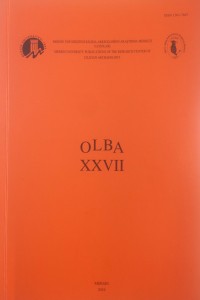Abstract
In 2014, a stele decorated with reliefs was found during an excavation undertaken by the villagers searching for water near the village of Akarca in the Avanos district which belongs to the province Nevşehir. The stele has a rounded top, four flat sides and belongs to the upper part of a larger (now missing) stele made from basalt. Figures were engraved in low relief technique on four sides of the stele and on the rounded top. The main theme the figures depict is religious; they reflect cultic/ritualistic and divine/ mythological scenes. A presentation scene is depicted on the observe of the stele (a), a winged deity and a worshipper on the right side (b), a banquet scene with an offering table involving three participants on the reverse (c), a storm god standing on top of the mountains and holding the halter of a bull as well as a goddess/priestess on the left side (d) and a mountain chain on the top (e). The style and iconographic features of the figures depicted on the Avanos-Akarca stele are foreign to the Anatolian region and reflect the characteristics of Old Syrian figurative art. One of the figures that illuminates the origin and history of the stele is the royal figure with a peaked cap on the front side of the stele (a). Similar figures occur on Syro-Cappadocian/Old Syrian colony style cylinder seals and seal impressions that were found at Kültepe-Kanesh Karum level II, and at Hammam et-Turkman; unprovenanced examples are in the Louvre Museum collection. Such figures from the same era also occur on basalt cult basins from Tell Mardikh-Ebla and on the gold plaque from Byblos. There must be a close relationship between the Avanos-Akarca stele royal figure and the Kültepe, Ebla, Byblos and Hammam et-Turkman figures. The figures in question were defined as a king and a god on the Kültepe seals, on the Ebla cult basins, and on the Byblos gold plaque. These examples show that the roles assumed by the figure with a peaked cap, depicted both as a worshipper and worshipped can change. The divine role of the royal figure on the Avanos-Akarca stele was emphasized by two mortals in the act of giving offerings. The stele must have been dedicated to a deified king. The cultic/ritualistic and divine/mythological scenes engraved on all four sides of the stone shed light on a cultic act with a banquet, organized in the name of the deified king in which the continuity of the kingdom is ensured by divine beings. The stele is an example of the figurative artworks in relief reflecting the complex cultic actions of the Old Syrian period. The stele belongs to the Middle Bronze Age I and II around 1900–1750 BC due to the close similarity with the early/Classical Old Syrian period stone relief examples from Ebla in terms of subject matter and stylistic features. The Avanos-Akarca stele is one of the few stone relief pieces from the Middle Bronze Age discovered in Anatolia, like the Harput relief1 uncovered in recent years. In this study, while the stylistic and iconographic characteristics of the figures on the stele are examined, answers are sought to questions like who the stele belongs to or the reasons of the cult actions related to the themes formed by the figurative motifs. Some possibilities are discussed about where and how the stele came to central Anatolia.
Keywords
References
- Alexander 1970 Alexander, R. L., “Une Masse D’Armes A Figures de L’Époque du Palais de Mari”, Syria XLVII, 37-49. Alp 2000 Alp, S., Hitit Çağında Anadolu, Çiviyazılı ve hiyeroglif yazılı kaynaklar. İstanbul. Amiet 1961 Amiet, P., La gyliptique Mésopotamienne archaique. Paris, Éditions du Cnrs. Amiet 1980 Amiet, P., Art of the Ancient Near East. New York, Harry N.Abrams, Inc. Archi 2011 Archi, A., “The Gods of Ebla”, The Netherlands Institute for the Near East and The Netherlands Institute in Turkey. Annual Report 2010, 3-11. Archi 2013 Archi, A., “Ritualization at Ebla”, Journal of Ancient Near Eastern Religions 13, 212-237.
Abstract
References
- Alexander 1970 Alexander, R. L., “Une Masse D’Armes A Figures de L’Époque du Palais de Mari”, Syria XLVII, 37-49. Alp 2000 Alp, S., Hitit Çağında Anadolu, Çiviyazılı ve hiyeroglif yazılı kaynaklar. İstanbul. Amiet 1961 Amiet, P., La gyliptique Mésopotamienne archaique. Paris, Éditions du Cnrs. Amiet 1980 Amiet, P., Art of the Ancient Near East. New York, Harry N.Abrams, Inc. Archi 2011 Archi, A., “The Gods of Ebla”, The Netherlands Institute for the Near East and The Netherlands Institute in Turkey. Annual Report 2010, 3-11. Archi 2013 Archi, A., “Ritualization at Ebla”, Journal of Ancient Near Eastern Religions 13, 212-237.
Details
| Primary Language | English |
|---|---|
| Journal Section | Research Article |
| Authors | |
| Publication Date | July 25, 2019 |
| Published in Issue | Year 2019 Issue: 27 |

